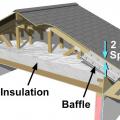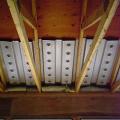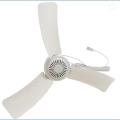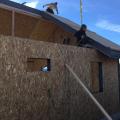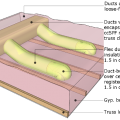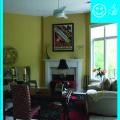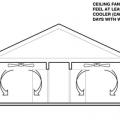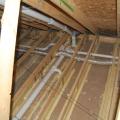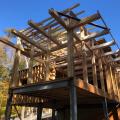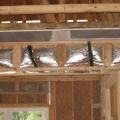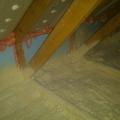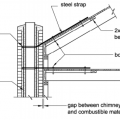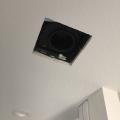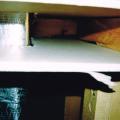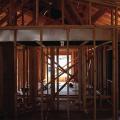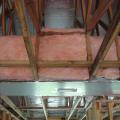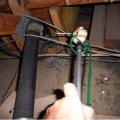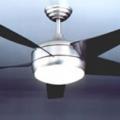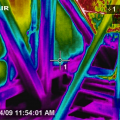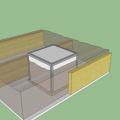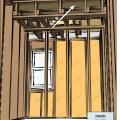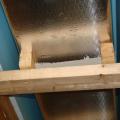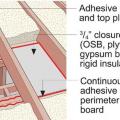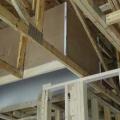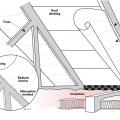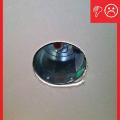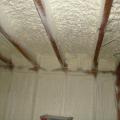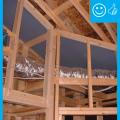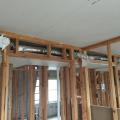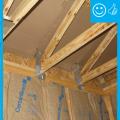Showing results 1 - 50 of 119
A site-built rafter roof with a raised top plate allows for more insulation underneath.
After all holes through the ceiling are air-sealed and the baffles have been installed, then the insulation can be installed.
Baffles provide an air space over the insulation to guide ventilation air from the soffit vents up along the underside of the roof deck
Because all of the structural load is carried by the SIP roof and wall panels, no trusses are needed, allowing the home to have vaulted ceilings and open interiors throughout.
Buried ducts are laid on the floor of a vented attic then covered with spray foam and blown attic floor insulation
Ceiling fan meets minimum clearance
Ceiling fans can be used to aid a night flush strategy by helping to cool down wall and floor surfaces more thoroughly at night, and by providing comfort ventilation during the day
Ceiling joists extend out to provide very strong roof overhangs that will resist uplift pressures in high winds.
Closed-cell spray foam insulation covers the attic floor to provide a continuous air control layer.
Cross section showing points of reinforcement and attachment to secure the chimney to the roof and ceiling joists.
Cut a neat hole in the ceiling with smooth edges in which the exhaust fan housing will fit snugly
Cut-away view showing unsealed gaps around a heating duct that goes through a wall
Dropped hallway ceiling duct chase with drywalled soffit
Dropped hallway ceiling with drywall
Failure in attic insulation effectiveness caused by wind washing pushing insulation away from the edges of the attic space.
Finished raised ceiling duct chase
Flat roof with cavity spray foam plus loose-fill insulation and gypsum board thermal barrier.
Floor cavity air pressure is measured by placing a tube into the floor cavity through a small drilled hole
Floor cavity pressure is measured by inserting a tube into the floor cavity using an extension pole
Infrared imaging shows cold conditioned air pouring out of the open floor cavities under this attic kneewall into the hot unconditioned attic
Install a continuous air barrier below or above ceiling insulation and install wind baffles.
Install a sealed enclosure over a non-IC rated recessed light fixture to air-seal the can and to prevent insulation from touching the recessed can light.
Install duct supports in line with ceiling trusses
Installing air barrier above a soffit
Installing an ENERGY STAR ceiling fan is a low-energy way to improve comfort in a designated cool room
Key connection points for a continuous load path for earthquake and high wind disaster resistance
Limited attic access may make it necessary to use a bore scope when inspecting for missing air barriers and insulation in existing buildings.
Radiant barrier sheeting can be stapled to the underside of the rafters or along the inside edge of the rafters
Raised ceiling duct chase installation technique
Raised ceiling duct chase is not visible as finished product
Raised heel energy trusses extend past the exterior wall and are deeper at the wall allowing room for full insulation coverage over the top plate of the exterior walls.
Right - A “flash” seal approach with spray foam provides a continuous air barrier between the ceiling and walls of the garage and the living space.
Right - a dropped ceiling below a taped plywood air barrier provides a service cavity for ducts and wiring.
Right - Air barrier is present between the dropped ceiling/soffit and the attic.
Right - Air barrier is present between the dropped ceiling/soffit and the attic.
Right - The HVAC ducts are located in conditioned space in a dropped hallway ceiling with very short duct runs for more efficient delivery.
Right - Wind baffle installation will allow proper insulation depth over the top plate.

